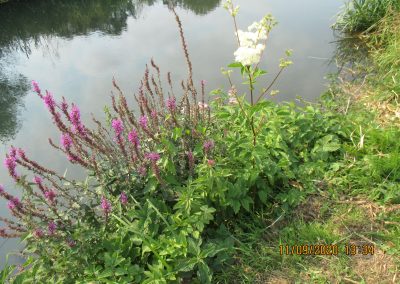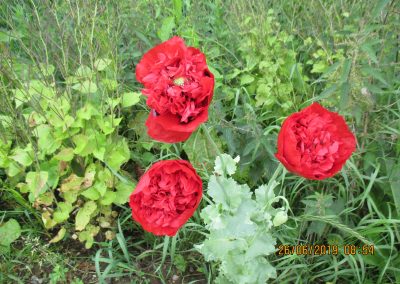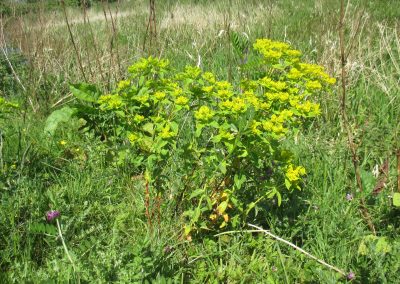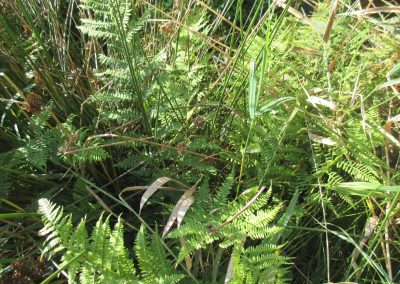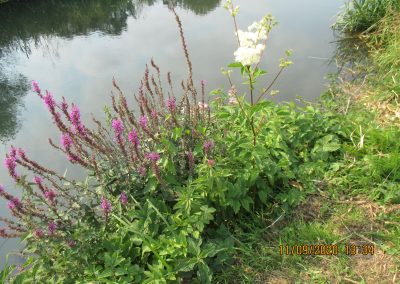Picture left.
Lythrum salicaria Puprple Loosestrife, Filipendua ulmaria Meadowseeet Eupatorium cannabinum Hemp Agrimony.
As seen along the canal.
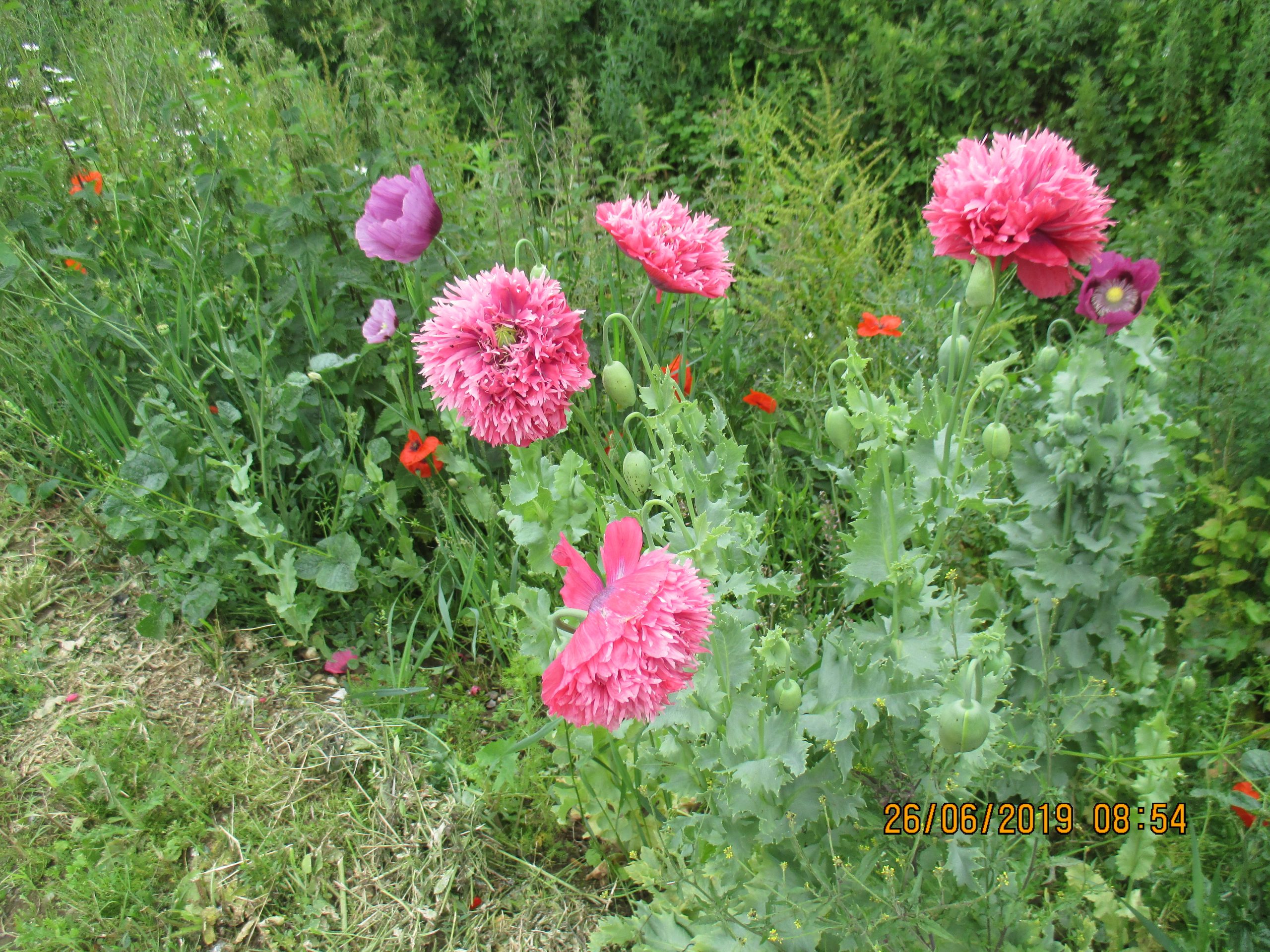
Picture left.
Papaver somniferum, Opium Poppy
As seen along the canal.
Plants of the canal
Congratulations to Suki Pryce, the Trust Wildlife Officer who has had the attached document published to the BSBI – The ‘Botanical Society of Britain and Ireland’. Visit her publication about the variety of plants found along the canal via this link – BSBI Newsletter Adventives
Habitats, Wildlife and Management between Swafield Bridge and Ebridge Lock
Introduction
The North Walsham and Dilham Canal (NWDC) is an important wildlife corridor in the North Norfolk area, and though the Swafield to Ebridge sections have been restored, they are still rich in different habitats. The NW&DC Trust looks after this part of the Canal, and aims to strike a balance between the needs of navigation, recreation, and wildlife conservation. Restoring and maintaining a working canal is a priority, but the Trust also wants to manage the corridor sympathetically so as to encourage its biodiversity and its desirable plants and animals. A remarkable 410+ plant species have been found in the restored area so far – including many intriguing non-native plants (Table 1), and some quite rare and precious natives. Notable animals that live or visit here include Water Voles, Otters, Kingfishers, and Little Egrets; there’s a wide variety of fish, and a host of butterflies, moths, dragonflies and other invertebrates.
Habitats and Their Management
The Canal corridor includes many types of habitat which provide homes, shelter or food for wildlife. First, there’s the canal bed – and though only the Ebridge section is ‘in water’ at the moment, the other two (which should be filled soon) are often damp or contain some water. On either side of the canal and its embankments are ditches or streams called ‘back sokes’, and in all these watery areas a wide range of aquatic and waterside wildlife thrives. Rare native plants found here include Water-plantain Alisma plantago-aquatica, Lady-fern Athyrium felix-femina, and Whorl-grass Catabrosa aquatica.
The canal bed is contained by embankments whose tops and sides are cut more or less regularly. This creates a short turf or medium height plant habitat, and also some bare ground (which can be a useful habitat in its own right eg for ground-living insects). In addition, buffer zones of less-often-cut vegetation are left along the embankment shoulders. The soke bank sides are cut much less frequently (from once a year to once every four years), and offer a ‘tall herb’ habitat. Invasive Alder, Elder and Willows are removed from the inner canal banks, as they would damage them if left to grow, but some tree or shrub growth is left in places along the sokes as it adds variety to the habitat. Because a variety of fill has been brought in to build up the embankments, many unusual plants have arrived with it, including species from gardens, farmland, wasteland, and industrial areas (Table 1).
The Canal also has other features in or beside it which provide different habitats. These include the now-dry ‘winding pools’ once used for repairs, or for turning canal boats; locks, sluices and bridges; and industrial areas, waste ground, and tipping sites. There’s also a small sandy heath-type area by Bacton Wood Lock, with ‘mini-cliffs’ and dry grassland. In addition, the Trust looks after Purdy’s Marsh – an area of reedbed which is a County Wildlife Site. (Himalayan Balsam is a big problem here, which the Trust does its best to control).
Outside the back sokes, the Canal is enclosed by a wide variety of habitats. Although it passes through arable and pasture fields, more than 90% of the strip immediately next door to it is ‘semi-natural’ and has developed on land unsuitable for farming. Habitats on these unmanaged areas include patches of woodland, grown-out hedges, scrub, reedbed, rough grassland, and wet meadows. The fact that the Canal is almost entirely contained within this belt of ‘wilderness’ makes it an even better refuge and corridor for wildlife.
The idea of having the whole Canal site designated as a County Wildlife Site has been put forward, and this may come about at some stage.
Volunteering – a GreenTeam?
Ideally, the Trust would like to form a ‘Green Team’ of volunteers who’d work mainly on the vegetation-habitat management side of things.
If you’re interested, please contact Wildlife Officer Suki Pryce via our ‘Contact Us’ page
Click HERE to view a list of plants surveyed at various locations along the canal
Added 19th January 2021
CANAL PLANT NEWS: New to the ‘Plant List’ This Year
The plants below are all new to the Canal plant list, which now stands at over 410 species: it’s amazing how new ones continue to emerge. I found some of these; but The Norfolk Flora Group joined me in recording parts of the Canal this year while surveying the wider area, and they spotted/identified species I either hadn’t noticed before, hadn’t recognised, or which were genuinely new arrivals. So many thanks to the NFG, their eagle eyes and their expertise.
Japanese Anemone Anemone x hybrida
Parsley-piert Aphanes arvensis
Thyme-leaved Sandwort Arenaria serpyllifolia
Black Spleenwort Asplenium adiantum-nigrum
Pot Marigold Calendula officinalis
Musk Thistle Carduus nutans
Musk Stork’s-bill Erodium moschatum
Jerusalem Artichoke Helianthus tuberosus
Broad-leaved Everlasting-pea Lathyrus latifolius
Scented Mayweed Matricaria camomilla
Spotted Medick Medicago arabica
Tufted Forget-me-not Myosotis laxa
Curled Pondweed Potamogeton crispus
Cowslip Primula veris
Broad-leaved Osier Salix x sericans (S. viminalis x S. caprea)
Alexanders Smyrnium olusatrum
Dense-flowered Mullein Verbascum densiflora
Blue Water-speedwell Veronica anagallis-aquatica
Squirrel-tail Fescue Vulpia bromoides
Out-of-Place’ Plants Found Along The North Norfolk and Dilham Canal Restored Sections,
Grouped by likely origins of Imported Fill
A = alien R= rare in Norfolk
|
Normally found on poor/dry/sandy/chalky soils: Chalk Knapweed Centaurea debeauxii, Common Centaury Centaureum erythrea, Wild Carrot Daucus carota, Hoary Cinquefoil Potentilla argentea R, Sticky Groundsel Senecio viscosus A, Heath Groundsel Senecio sylvaticus Normally found on dunes, sea cliffs etc: Sea Milkwort Lysimachia maritima R Associated with saline environments: Narrow-leaved PepperwortLepidium ruderale Probably came in on agricultural/countryside soil:Fool’s Parsley Aethusa cynapium, Fiddleneck Amsinckia micrantha A, Wild Oat Avena fatua A, Sugar Beet Beta vulgaris ssp vulgaris, Cockspur Echinocloa crus-galli A, Bifid Hemp-nettle Galeopsis bifida R,Hedgerow Crane’s-bill Geranium pyrenaicum, Scarlet Pimpernel Lysimachia arvensis, Musk Mallow Malva moschata, White Melilot Melilotus alba R, Wild Radish Raphanus raphanastrum, Soapwort Saponaria officinalis, Field Madder Sherardia arvensis, Field Penny-cress Thlaspi arvense, Alsike Clover Trifolium hybridum R, Great Mullein Verbascum thapsus Probably came in on urban/waste ground spoil: Common Ragweed Ambrosia artemisiifolia A, R, Buddleja Buddleja davidii A, Greater Celandine Chelidonium majus, Annual Wall-rocket Diplotaxis muralis, Perennial Wall-rocket Diplotaxis tenuifolius R, Canadian Fleabane Erigeron canadensis A, Jersey Fleabane Erigeron sumatrensis A, Annual Beard-grass Polypogon monspeliensis A, Water Bent Polypogon viridis A, Narrow-leaved Ragwort Senecio inaequidens A, R, Tomato Solanum lycopersicum A (probably from sewage sludge) Probably came in on garden/allotment soil: Double Sneezewort Achillea ptarmica flore pleno A, Soft Lady’s Mantle Alchemilla mollis A, Hirsute Garlic Allium trifoliatum A, Balkan Anemone Anemone blanda A, JapaneseAnemone Anemone x hybrida A, R, Snapdragon Antirrhinum majus,ColumbineAquilegia vulgaris A, Red Garden Orache Atriplex hortensis var rubra A, Swiss Chard Beta vulgaris ssp cicla, Red-maids Calandrinia ciliate R, Pot MarigoldCalendula officinalis A,Peach-leaved Bellflower Campanula persicifolia A,Cornflower Centaurea cyanus A, Greater Celandine Chelidonium majus, Galingale Cyperus longus, Californian Poppy Eschscholzia californica A, Caper Spurge Euphorbia lathyrus, Balkan Spurge Euphorbia oblongata A, R, Snowdrop Galanthus agg, Goat’s-rue Galega officinalis A, R, Chiloe Avens Geum quellyon A, R, Jerusalem Artichoke Helianthus tuberosus A, R, Spainish Bluebell Hyacinthoides hispanicus A, Broad-leaved Everlasting-pea Lathyrus latifolius R, Shasta Daisy Leucanthemum x superbum A, Summer SnowflakeLeucojum aestivum A,Poached Egg Plant Limnanthes douglasii A, R, LobeliaLobelia erinus A, Welsh Poppy Meconopsis cambrica, Apple Mint Mentha x villosa A, Grape Hyacinth Muscari armeniacum A, Opium Poppy Papaver somniferum A, Flowering Currant Ribes sanguineum A, Greek Mallow Sidalcea malviflora A, Michaelmas Daisy Symphyotrichon agg A, Comfry ‘Hidcote Blue’ Symphytum x hidcotense A, Nasturtium Tropaeolum majus A, Argentinian Vervain Verbena bonariensis A |
Very many thanks to Suki Pryce, Wildlife Officer who provided this report – December 2020

